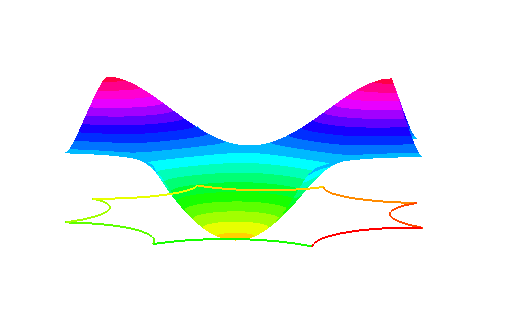

Here is an example that works with curved periodic boundary conditions on finite element vector spaces (proposed by D. Floor and W. Boxleitner). Poisson problem is solved with periodic boundary conditions.
 |  |  |
download example: periodic_curved.edp
cout<<" \n\n Creating boundaries \n";
/*
polygon layout:
_3_
4/ \2
5| |1
6\ ___/8
7
sides identification
1-5
2-6
3-7
4-8
*/
border C1 (t = 5*pi/4, 3*pi/4) { x = sqrt((sqrt(2)-1)/2)*cos(t) + sqrt((sqrt(2)+1)/2) ;
y = sqrt((sqrt(2)-1)/2)*sin(t) ; label=1 ;}
border C2 (t = 3*pi/2, pi) { x = sqrt((sqrt(2)-1)/2)*cos(t) + sqrt(2)/2*sqrt((sqrt(2)+1)/2) ;
y = sqrt((sqrt(2)-1)/2)*sin(t) + sqrt(2)/2*sqrt((sqrt(2)+1)/2) ; label=2;}
border C3 (t = 7*pi/4, 5*pi/4) { x = sqrt((sqrt(2)-1)/2)*cos(t) ;
y = sqrt((sqrt(2)-1)/2)*sin(t) + sqrt((sqrt(2)+1)/2); label=3 ;}
border C4 (t = 2*pi, 3*pi/2) { x = sqrt((sqrt(2)-1)/2)*cos(t) - sqrt(2)/2*sqrt((sqrt(2)+1)/2) ;
y = sqrt((sqrt(2)-1)/2)*sin(t) + sqrt(2)/2*sqrt((sqrt(2)+1)/2) ; label=4 ;}
border C5 (t = 9*pi/4, 7*pi/4) { x = sqrt((sqrt(2)-1)/2)*cos(t) - sqrt((sqrt(2)+1)/2) ;
y = sqrt((sqrt(2)-1)/2)*sin(t) ; label=5 ;}
border C6 (t = pi/2, 0) { x = sqrt((sqrt(2)-1)/2)*cos(t) - sqrt(2)/2*sqrt((sqrt(2)+1)/2) ;
y = sqrt((sqrt(2)-1)/2)*sin(t) -sqrt(2)/2*sqrt((sqrt(2)+1)/2) ; label=6 ;}
border C7 (t = 3*pi/4, pi/4) { x = sqrt((sqrt(2)-1)/2)*cos(t) ;
y = sqrt((sqrt(2)-1)/2)*sin(t) - sqrt((sqrt(2)+1)/2) ; label=7 ;}
border C8 (t = pi, pi/2) { x = sqrt((sqrt(2)-1)/2)*cos(t) + sqrt(2)/2*sqrt((sqrt(2)+1)/2) ;
y = sqrt((sqrt(2)-1)/2)*sin(t) - sqrt(2)/2*sqrt((sqrt(2)+1)/2) ; label=8 ;}
cout<<"\n\nBuilding mesh\n";
int vertnum = 30;
mesh Th = buildmesh(C1(vertnum)+C2(vertnum)+C3(vertnum)+C4(vertnum)+C5(vertnum)+C6(vertnum)+C7(vertnum)+C8(vertnum),fixeborder=true);
//Adapting the mesh messes up the periodic boundary conditions
//func metric = 4/(1-x^2-y^2)^2;
//mesh ATh = adaptmesh(Th,metric);
cout<<"\n\n Creating function space \n";
real side = sqrt(3/4*2^(7/8)+2^(3/8)+1/2);
//dist15 = (x,y).(0,side)
func dist15 = y * side;
//dist26 = (x,y).(-sqrt(2)*side,sqrt(2)*side)
func dist26 = (y-x)*sqrt(2)*side;
//dist37 = (x,y).(side,0)
func dist37 = x * side;
//dist48 = (x,y).(sqrt(2)*side,sqrt(2)*side)
func dist48 = (y+x)*sqrt(2)*side;
func perio = [[1,dist15],[5,dist15],[2,dist26],[6,dist26],[3,dist37],[7,dist37],[4,dist48],[8,dist48]];
//function space with periodic boundary conditions and the solution of \nabla ^2 u=-xy
fespace Vhp(Th,P1, periodic=perio);
Vhp up,vp;
func g = x*y;
solve Poissonp(up,vp,solver=LU) = int2d(Th)(dx(up)*dx(vp)+dy(up)*dy(vp))-int2d(Th)(g*vp);
plot(up,wait=1);
//function space without periodic boundary conditions and the solution of \nabla^2 u=-xy with u=0 at the boundaries:
fespace Vh(Th,P1);
Vh u,v;
func f = x*y;
solve Poisson(u,v,solver=LU) = int2d(Th)(dx(u)*dx(v)+dy(u)*dy(v))-int2d(Th)(f*v)+on(C1,C2,C3,C4,C5,C6,C7,C8,u=0);
plot(u,wait=1);